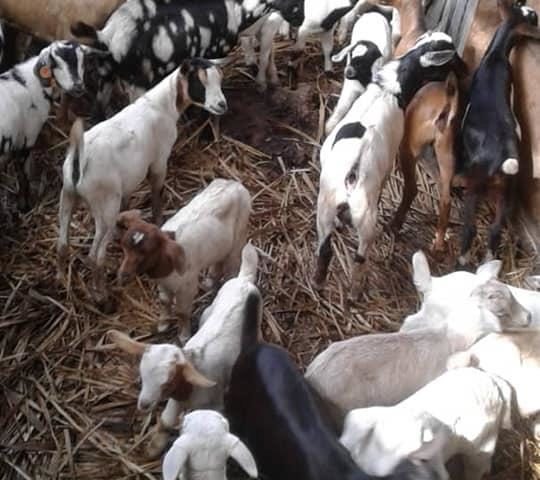By Joseph Mugenyi
Compared to cattle, goats are the easiest dairy animals to keep because they require little space, minimal capital, have higher prolificacy (number of litter born per kidding), are generally hardy and their milk is much more nutritious and digestible.
Lately, there is increased interest in dairy goat farming, but many farmers don’t know how to maximise profit from the animals.
Consider the following guidelines if you want to succeed in this venture:
Go For The Right BreedSaying that you want high-milk producing goat breed is starting on the wrong footing. Profitability of any dairy enterprise does not solely depend on milk production.
First, ask yourself; is the high-milk producing goat able to adapt or survive in my local environment? Can my production resources be adequately adjusted to sustain the high-milk producing breed? How about the reproduction efficiency of the breed I am going for?
After that, go for a goat breed that produces a fairly reasonable amount of milk given the available production resources, is able to adapt quickly and one that is reproductively sound.
They could be grade/crossbreeds or pure breeds but records say it all.

Udder factors to consider when buying dairy goats include ensuring that teats face slightly forward and are not too close for ease of milking.
Good goats should have a shiny coat, bright eyes, look alert and have good body conditions. This is at the minimum, in some cases you can go much further and have a vet or animal expert examine the goat for you before you purchase.
The common dairy goat breeds reared are Saanen, Toggenburg and Alpines, and their crosses. Toggenburgs thrive well in medium to high agricultural potential environment but suffer from heat stress in very hot climates.
They are high quality goats, with milk production potential of about five litres if kept under good management and resources. The Saanen breed however is the highest milk producer on average.
The crossbreeds also do well, are very hardy and adapt to a wide range of environmental and feeding conditions.
FeedingAll the production aspects and health of your stock are greatly defined by the design of the feeding programme you adopt.

Goats are naturally browsers, very inquisitive feeders, and therefore, should be fed balanced diets in energy, protein, minerals, vitamins and clean water when housed.
They relish variety, which calls for variation of different nutrients sources, especially under zero-grazing situations.
Variety of grasses, shrubs and plants make good feed for these animals. Energy feeds are required for maintenance of body condition and generally all body functions.
Energy sources comprise napier grass, Rhodes grass, Kikuyu grass, molasses and cereals like maize.
Proteins are required for growth, reproduction, other than milk production. Sources include fodder trees and legumes such as lucerne, calliandra, leucena, desmodium, mulberry, sweet potato vines, dairy meal, cotton seed cake, sunflower cake, soy bean cake and other oil seed cakes.

Like in cattle farming, under zero-grazing, the feed can be chopped and the goat given clean water and ad libitum mineral salts as well. Mineral deficiency will definitely affect production.
Dairy goats can also be fed on hay or other dried grasses. The quantity of feeds needed by dairy goats vary depending on their weight and stage of development.
As a general rule, a goat should feed 3.5 per cent of its body weight of dry matter.
If well-fed and watered, goats rarely fall prey to diseases, making the venture very profitable.
Housing
Dairy goat barns should have raised floors to keep them dry. Goats fear dumpy places unlike cows. In addition, the housing should be easy to clean and adequately fenced due to their small size.
The housing should consider adequate ventilation for optimum health. Fresh dry hay or straws could be used as bedding material.
If space allows, an outside area for exercise and sunning can be made as goats enjoy entertaining themselves. Inside this space, you can provide ‘toy objects’ (not dangerous ones) to give them some hours of caprine entertainment.
Tree bases, old tyres or rocks can be offered to give them the ‘mountain’ impression for exercise and jumping that they enjoy.
Play and exercise will help in building strong bones and good muscle. If kept in areas with minimal space, they become bored, depressed and this affects their milk production. Stressed animals are also less resistant to diseases.
Disease PreventionGoats are highly susceptible to pneumonia and worms. Sometimes, the presence of worms is manifested by worms or eggs in goat’s droppings, thin and rough hair coat.
This leads to general poor health and subsequently a drop in milk production. As a control measure, regular deworming should be done, depending on the drug used.
Common signs of pneumonia include sneezing, coughing, heavy breathing and withdrawal. Early diagnosis of sick goats is important for successful treatment, therefore, if you suspect pneumonia, quickly consult a veterinarian.
Timely vaccination is also mandatory to keep your goats free from diseases like Contagious Caprine Pleuropneumonia (CCPP) and tetanus.
Ticks and fleas are also common in goats. Spray the animals and their barns regularly.
Have bio-security measures and keep their surroundings hygienic lest diseases like mastitis and coccidiosis strike.
Sources of Good Dairy GoatsThey include Dairy Goats Association of Uganda, veterinary research centres and model farmers.
Goats can be bred through natural breeding or Artificial Insemination (AI). AIthough AI is not so popular, the services can be accessed from professional veterinary doctors.
For natural breeding, the recommended young buck to doe ratio is 1:25. Under suitable management, goats come on heat at eight months, sometimes earlier. However, it is recommended to mate the does from 12 months onwards.
The animals experience a heat period lasting between 24 – 26 hours and have a gestation period of 150 days.
Get all the agricultural information here bi-weekly. Mugenyi Joseph (MJ Farmer) is a practicing Agribusiness entrepreneur based in Kibiito and a software engineering student at Makerere University. He can be reached on 0701-443309, Email: mugenyijosemj@gmail.com




